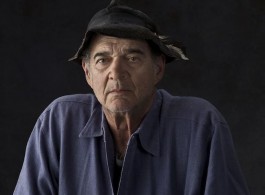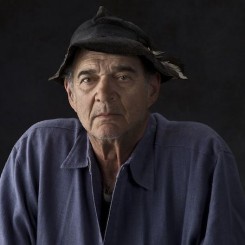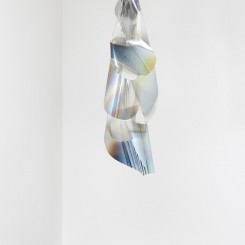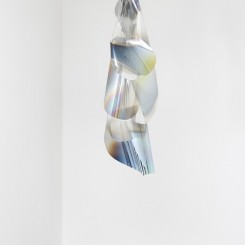White Cube is pleased to present an exhibition of new works by Larry Bell. This exhibition, his first in Hong Kong, will include a new series of sculpture and works on paper. Bell’s career has spanned 50 years, but throughout he has focused on light and the interface of surface. A tireless experimenter, his methodology is characterised by spontaneity, intuition and improvisation evidenced in works that have ranged from the small scale to total environments and large installations.
Bell began his career in the early 1960s as a painter but soon made constructions and then sculpture. It was through his sculptural practice that he discovered an industrial metallic plating process that produced gradient coated glass, paper and plastic surfaces, a process that could visually create virtual spatial volume and translucency of an object. This technique, which Bell continues to explore today, led him to create his key works, such as the signature glass ‘Cube’ and ‘Standing Wall’ sculptures. For this exhibition, Bell has created a new group of ‘Light Knots’ which also utilise this process. These gravity- defying, weightless sculptures are formed from pliable, curvaceous-shaped sheets of polyester film that have been coated with various metals and quartz. The fluid sheets are then knotted to create complex spatial mirrored forms which transmit, absorb and reflect the light in their direct surroundings. Bell frequently hangs his ‘Light Knot’ sculptures from the ceiling, but in this case, they have been suspended or trapped within Optium cases. Their highly dynamic forms, frozen in motion like his graceful, three- dimensional ‘Vapor Drawings’ seem to shift into multi-layers of shapes and light.
Likewise, Bell’s new series of collages on red Hiromi paper play with ideas of perception and notions of spatial ambiguity. Bell refers to the language of Cubism in these works – in particular to its dynamic collision of visual planes – through layered rectangles of mirrored materials placed on a vivid red background. While the works are purely abstract and two-dimensional, their forms reflect surfaces creating a shimmering vortex of depth and light, emitting a rainbow of colours that is made visible through the interference of light at various wavelengths hitting the work’s surface.
Larry Bell lives and works between Los Angeles and Taos, New Mexico. He has shown extensively across the United States and internationally with museum solo exhibitions at Pasadena Art Museum, California (1972); Oakland Museum of Art, California (1973); Fort Worth Art Museum, Dallas, Texas (1975 and 1977); Washington University in St. Louis, Missouri (1976); Detroit Institute of Arts, Michigan (1982); Museum of Contemporary Art, Los Angeles (1986); Denver Art Museum, Colorado (1995) and Albuquerque Museum, New Mexico (1997). More recent solo exhibitions include Kunstmuseum Bergen, Norway, which toured to Reykjavik Municipal Art Museum, Iceland (1998) and a survey exhibition at the Carré d’Art Musée d’art Contemporain de Nîmes, France (2011) and more. In 2012 Bell was included in the Getty Center’s major exhibition ‘Pacific Standard Time: Art in LA 1945-1980’, part of a state-wide celebration of the West Coast contemporary art scene from the 1960s onwards. In October 2014 the Chinati Foundation in Marfa, Texas will curate an exhibition dedicated to his large glass installations.
Larry Bell
Throughout his career Larry Bell has made investigations into the properties of light on surface. By experimenting with the nature of surface and its relationship to space, Bell has devised a methodology characterised by spontaneity, intuition and improvisation.
Bell began his career in 1959 and his earliest works consisted of abstract, monochrome paintings on paper and shaped canvases whose outlines corresponded to the silhouette of a box drawn in isometric projection. Panes of glass and then mirrors were substituted for parts of the painted design and this exploration of spatial ambiguity eventually evolved into sculptural constructions made of wood and glass. These works represent the genesis of Bell’s later glass cubes and standing glass-panel wall sculptures.
From 1963 onward, Bell began exploring the passing of light through the cube sculptures, deploying a technique of vacuum deposition whereby thin films were added to the clear glass panels. Bell found that these glass cubes, presented on transparent pedestals, offered the viewer the essence of the captured light, becoming, in the process, tapestries of reflected, transmitted and absorbed light. Challenging notions of mass, volume and gravity in one single measure, the cubes appeared to float on the light between the floor and the work.
From 1968 to 1969 Bell commissioned the building of a coating device in order to produce work on a more environmental scale. During the plating process, thin metal films are deposited onto another material, mainly glass, resulting in a coating that allows light to be reflected, transmitted and absorbed simultaneously. He began creating sculptural installations with large sheets of glass that were rendered partly mirrored and partly transparent through the vacuum deposition procedure, thereby making the glass surfaces almost disappear and volumes become weightless. The colours which become visible are known as ‘interference colour’; an illusion which results when light hits the sculptures’ surface. Throughout this period, Bell produced interior wall environments, such as The Black Room for both the Museum of Modern Art, New York (1969) and the Tate Gallery (1970).
In 1978 Bell began experimenting with depositing the coatings on paper, finding in the process that the paper did not transmit light but only reflected or absorbed it. This body of work, known as ‘Vapor Drawings’, continues to this day. In the early 1980s Bell began combining different surface qualities as layers within the ‘Vapor Drawing’ oeuvre, such as Mylar and laminating film, to create the so-called ‘Mirage works’ – a mirage being an illusion which results from a combination of heat and light.
Bell’s more recent ‘Light knot’ sculptures developed from these ‘Mirage works’, eschewing their paper and laminate film and using only Mylar. These fluid works are composed of pliable, curvaceous-shaped sheets of polyester film that have been coated with metals and quartz. Highly reflective, the sheets are twisted into a knot and hung from a ceiling. Ceaselessly in motion, propelled by any slight air movement, these undulating sculptures act like a series of mirrors that reflect the viewer and their immediate spatial surroundings.
Larry Bell lives and works between Los Angeles and Taos, New Mexico. He has shown extensively across the United States with museum solo exhibitions at Pasadena Art Museum, California (1972); Oakland Museum of Art, California (1973); Fort Worth Art Museum, Dallas, Texas (1975 and 1977); Washington University in St. Louis, Missouri (1976); Detroit Institute of Arts, Michigan (1982); Museum of Contemporary Art, Los Angeles (1986); Denver Art Museum, Colorado (1995) and Albuquerque Museum, New Mexico (1997). More recent solo exhibitions include Kunstmuseum Bergen, Norway, which toured to Reykjavik Municipal Art Museum, Iceland(1998) and a survey exhibition at the Carré d’Art Musée d’art Contemporain de Nimes, France (2011). In 2012 Bell was included in the Getty Center’s major exhibition ‘Pacific Standard Time: Art in LA 1945-1980’, part of a state-wide celebration of the West Coast contemporary art scene from the 1960s onwards. In October 2014 the Chinati Foundation in Marfa, Texas will curate an exhibition dedicated to his large glass installations.





